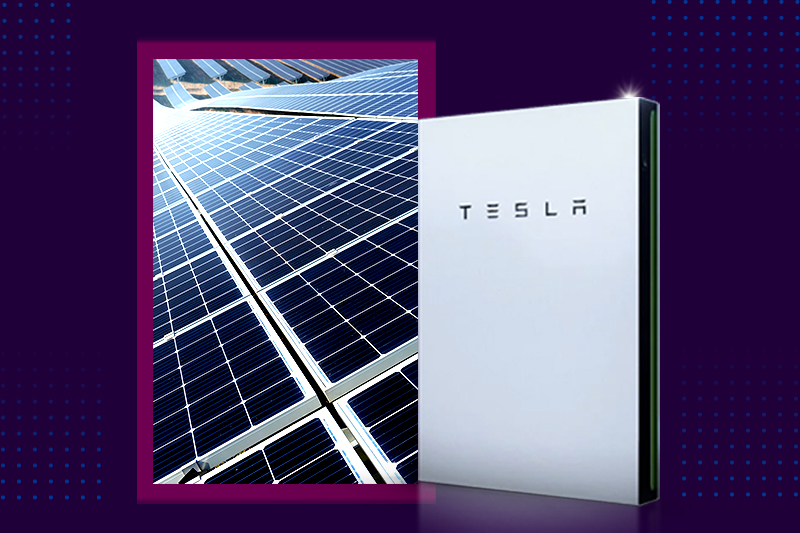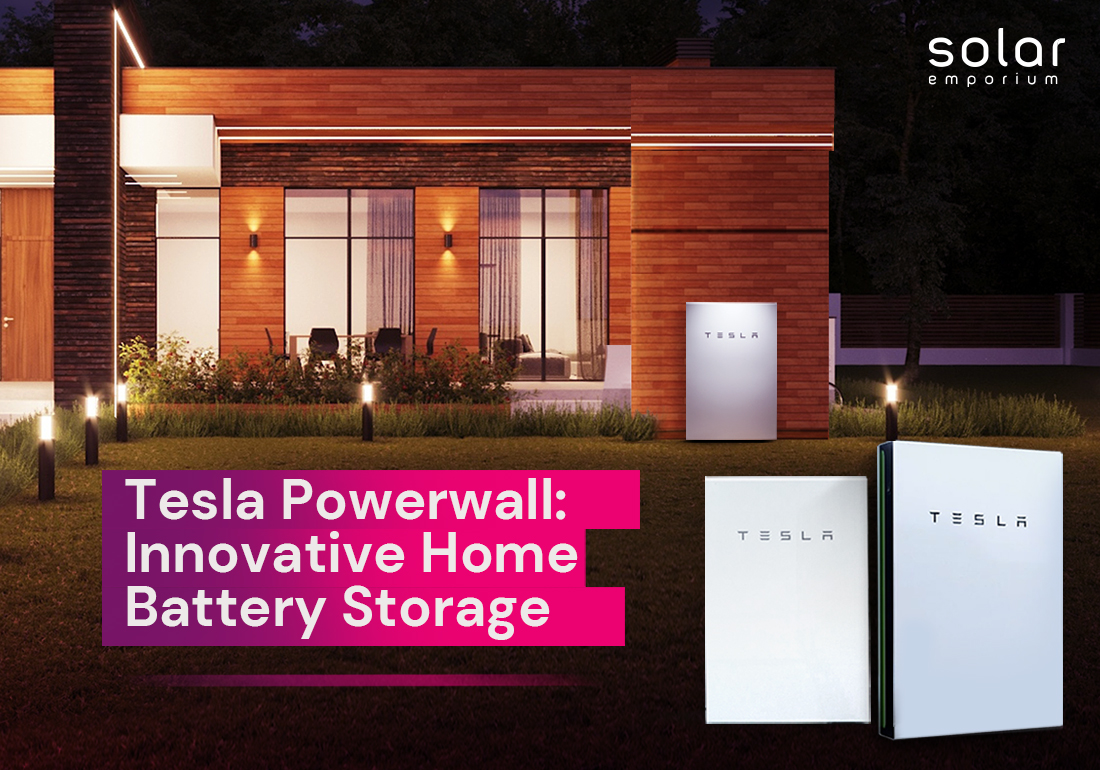More Australians are installing solar panels in their homes. As payments for selling extra solar energy back to the grid drop, more people are using batteries to store their leftover solar energy.
Like other battery systems, Tesla is becoming well-known in Australia. But is the Tesla Powerwall a good choice for Australian homes?
The Tesla Powerwall is an innovative home battery storage solution that integrates seamlessly with your existing solar system.
The Powerwall provides a consistent power supply to your home by storing energy generated by your solar panels, even when the sun is not shining. This home battery system does more than just store energy.
It also provides backup power during power outages, ensuring that your home is powered and functional when you need it most.
A home battery can help you use twice as much solar energy. Installing a Tesla Powerwall will double your benefits and be better for the environment.
However, how fast it pays off depends on how much energy you generate. So, there are several things to consider when deciding if the Tesla Powerwall is worth it.
If you’re an Australian looking for a home solar battery, consider the Tesla Powerwall. It’s the most popular home battery right now, and in this article, we’ll look at why it’s Australia’s favorite.
What Is Tesla Powerwall?
The Tesla Powerwall, made by Tesla, is a rechargeable lithium-ion battery for homes. It stores electricity for use with solar panels and helps manage energy use throughout the day.
The Powerwall is designed to make your home more energy-independent. It provides continuous backup power, reduces your home’s carbon footprint, and lowers electricity bills.
Powerwall is a smart system that can be customized to fit your specific energy needs. It charges from solar panels, ensuring that energy is always available when required.
It also acts as a backup power source. The Powerwall was first released in 2015 in small amounts. Now, Tesla offers larger battery storage options – the Powerpack for businesses and the Megapack for the power grid.
How Does Powerwall Work?
A powerwall lets you store energy for later use and works with solar panels to give you security and financial benefits. Each Powerwall system includes energy monitoring, metering, and smart controls.
The Tesla app allows you to customize and control everything. Over time, the system learns your energy habits and receives updates to improve and add new features.
There are two types of powerwalls: Powerwall and Powerwall+.
Powerwall is a rechargeable home battery system that works with solar panels. A system can have up to ten Powerwalls, which can be a mix of Powerwall+ and regular Powerwall.
Powerwall+ has extra features for better solar integration, resulting in a cleaner setup with less equipment.
It has built-in energy metering to help you accurately monitor your solar energy production and home energy use in real time.
Powerwall+ can smartly power heavy equipment, and its direct solar integration helps recharge the battery during power outages, improving the off-grid experience.
Tesla Powerwall Integration

Solar And Tesla Powerwall
Using Powerwall with solar panels is the best way to get the most out of your system. It lets you use solar power anytime, day or night.
Powerwall+ offers a complete solution, providing solar backup for whole homes. Regular Powerwall can be added to existing solar systems.
Since Powerwall is an AC-coupled system, it works with standard home energy inverters. To ensure it works well during power outages, you need at least one Powerwall for every 7.6 kW AC of solar in the backup circuit.
Generators And Powerwalls
You can add Powerwall to a system that already has a backup generator and an Automatic Transfer Switch (ATS) or Manual Transfer Switch (MTS).
Usually, a Powerwall is installed between the utility meter and the transfer switch. It can charge from solar while the grid is working.
However, the Powerwall and the generator aren’t directly connected, so the Powerwall doesn’t charge from the generator.
The powerwall provides backup power immediately during an outage, even before the generator starts. The generator turns on only when the Powerwall’s charge is low or if the power demand exceeds what the Powerwall can provide.
When the grid power returns, the generator shuts off, and the power can be recharged from solar again. With an MTS, you have to switch to use the generator for power manually.
Electric Vehicle Charging & Powerwall
Powerwall can send stored solar energy to your electric vehicle through your home’s electrical panel, but there isn’t a direct connection between Powerwall and the charging equipment.
While rechargeable energy storage has been developing for years, home solar storage has only recently become popular.
Although the Tesla Powerwall wasn’t the first solar battery, it gained the most attention. The Tesla Powerwall 2 is considered one of the top solar batteries available.
So, does the Tesla Powerwall live up to the hype? Solar Emporium’s experts have reviewed the entire range, including its specs, prices, and capabilities, to help you decide if it’s worth installing in your home.
How Long Does A Tesla Powerwall Battery Last When Fully Charged?
On average, one Powerwall can run ten 100-watt light bulbs for 12 hours, while the average home uses 28 kWh per day.
One Powerwall can power such a home for 12 hours. Two Powerwalls can power it for 18 hours, and three Powerwalls can power it for 24 hours.
Having more power increases the protection time for the house. The more Powerwalls you have, the longer your home can stay powered.
Pairing a Powerwall with a solar panel system is ideal because the solar panels can continuously recharge the Powerwall.
With solar panels, a powerwall can run a home indefinitely. Without solar, it can’t recharge until the grid power comes back.
How much is a 10kW Tesla Powerwall?

In Australia, a Tesla Powerwall 2 with a capacity of 14 kWh costs around $15,000 to $16,000, including installation. This price can vary depending on the location and the specific installation requirements.
The Tesla Powerwall is currently one of the most popular home battery systems due to its high capacity and integration with solar panels.
If you’re considering a Tesla Powerwall for a 10kW solar system, this price gives a good estimate of what to expect. However, additional costs may arise if you need extra equipment or have specific installation needs.
By submitting this form, you consent to be contacted by Solar Emporium and receive communications from time to time. Please view our privacy policy for further information.
What is The Payback Time for Tesla Powerwall?
Your Powerwall will save you money on your energy bills and will pay for itself over several years. The average payback period for solar panels is between eight and 12 years.
However, some homeowners may not see a full return on their investment (ROI) for up to 15 years.
The time it takes to see an ROI on your Powerwall depends on factors like your location, energy costs, net metering availability, and the amount of sunshine you receive.
You might see a faster ROI if you live in an area with:
Plenty of Sunshine: More sunlight means more solar energy can be converted into electricity. This allows you to power your home and store extra energy more effectively.
High Energy Costs: If energy costs are high in your area, you’ll save more by using solar power instead of relying on the grid.
Net Metering: If your utility company offers net metering, you can send excess energy back to the grid for credits, which you can use later.
These factors can help you achieve a quicker payback period and start saving more money sooner.
Tesla Powerwall Alternatives in Australia

Sungrow Battery
The Sungrow Battery is a popular choice for Aussie homeowners because it’s excellent at saving energy and it works well.
It can store up to 6.8 kWh of energy, but if you need more, you can add extra parts to make it hold up to 102.4 kWh. It’s made to work with most solar devices and is easy to add to your current solar setup. Plus, it’s guaranteed to work well for 10 years.
Eveready Battery
The Eveready Battery is another good choice for Aussie homeowners. It can store up to 5.6 kWh of energy, but you can add more parts to make it hold up to 22.4 kWh.
It’s easy to install and works with most solar devices. Like the Sungrow, it’s guaranteed to work well for 10 years.
Energizer Battery
GoodWe Home Battery
GoodWe makes two types of batteries: the Lynx Home U Series and the Lynx Home F Series. These batteries are known for being exceptional at saving energy and are also reliable.
They work with GoodWe inverters, and you can choose different sizes based on your needs. Plus, they come with a 10-year guarantee.
The Alpha ESS
German engineers make the Alpha ESS, which can be used for new setups or upgrades to old ones. It’s meant to help you save money on energy bills and switch to a more eco-friendly way of powering your home.
Contact Solar Emporium for any solar solution or home battery needs. Get a free solar quote today!







